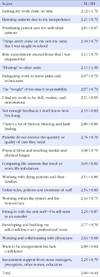Abstract
Methods
Participants were 216 newly graduated nurses with less than 1 year experience in 5 university and 10 general hospitals in Busan, Ulsan and Gyeongnam, A self-report questionnaire was completed by the nurses between November 18 and December 25, 2013. Data were analyzed using t-test, ANOVA and hierarchial multiple regression analysis with the SPSS/WIN 21.0 Program.
Results
Average scores for work environment and environmental reality shock were 2.63±0.33 and 2.66±0.43 points respectively. Regression analysis showed that with the nurses' demographic and work characteristics controlled, work environment explained 4.2% of the reality shock. Factors significantly affecting reality shock included nurses' changing residence because of job (β=.21, p=.001), whether they were able to work on the unit of their choice (β=-.13, p=.031) and whether they had a choice in days off (β=-.14, p=.038).
Conclusion
When these factors are considered, reduction in nurses' reality shock requires improvement in work environment, placing new nurses in a department of their choice and allowing them a choice in off-duty days. These measures would also help achieve organizational goals and develop the new nurses as professional nurses.
Figures and Tables
References
1. Bowles C, Candela L. First job experiences of recent RN graduate: Improving the work environment. J Nurs Adm. 2005; 35(3):130–137.
2. Kramer M. Reality shock; why nurses leave nursing. Saint Louis: CV Mosby;1974.
3. Kim H. A study of reality shock and teacher efficacy among inservice teachers: Focus on early childhood and elementary school teachers. J Korea Open Assoc Early Child Educ. 2012; 17(2):151–173.
4. Zapf D, Gross C. Conflict escalation and coping with workplace bullying: A replication and extension. Eur J Work Organ Psychol. 2001; 10(4):497–522. http://dx.doi.org/10.1080/13594320143000834.
5. Moran CM. Preceptor programs [Internet]. King of Prussia, PA: ADVANCE Newsmagazines;2002. cited 2014 March 23. Available form: http:// nursing.advanceweb.com/Article /Preceptor-Programs.aspx.
6. Knecht PA. New Grads: You Are not alone [Internet]. King of Prussia, PA: ADVANCE Newsmagazines;2002. cited 2014 March 23. Available from: http://nursing.advanceweb.com/Article/New-Grads-You-Are-Not-Alone.aspx.
7. Stacey G, Hardy P. Challenging the shock of reality through digital storytelling. Nurse Educ Pract. 2011; (2):159–164. http://dx.doi.org/10.1016/j.nepr.2010.08.003.
8. Yoon SH. A study on new graduate nurses' clinical experience of adaptation. J Korean Acad Nurs Adm. 2002; 8(1):55–72.
9. Hospital Nurses Association. Hospital Nurses Association work report: Hospital Nurses staffing state survey. Seoul: Hospital Nurses Association;2012.
10. Yun HM, Kim JS. An analysis of the factors affecting turnover intention of new nurses. Glob Health Nurs. 2012; 2(2):52–61.
11. Hwang SY, Lee EJ, Na DM, Lee GS, Sun GS, Lee CS. The Clinical experiences of newly-qualified nurses. J Korean Acad Nurs Adm. 2002; 8(2):261–271.
12. Kim JY, Kim IS. Experience of preceptorship for newly employed nurses. Clin Nurs Res. 2005; 10(2):75–88.
13. Park JH, Chun IS. The lived experience of newly employed nurses: Phenomenological study. Qual Res. 2008; 9(2):99–110.
14. Kramer M, Brewer BB, Maguire P. Impact of healthy work environments on new graduate nurses' environmental reality shock. West J Nurs Res. 2013; 35(3):348–383. http://dx.doi.org/10.1177/0193945911403939.
15. Kang YB. The effects analysis of the hospital organizational characteristics on organizational commitment and achievement [master's thesis]. Gyungsan: Yeungnam University;2010.
16. Lee EH, Chang SJ, Kim HY, Roh JH, Park EJ, Won JU. Relationship between job stress and turnover of registered nurses in a university hospital. Korean J Occup Environ Med. 2007; 19(2):93–104.
17. Christmas K. How work environment impacts retention. Nurs Econ. 2008; 26:316–318.
18. Lake ET. Development of the practice environment scale of the nursing work index. Res Nurs Health. 2002; 25(3):176–188. http://dx.doi.org/10.1002/nur.10032.
19. Baernholdt M, Mark BA. The nurse work environment, job satisfaction and turnover rates in rural and urban nursing units. J Nurs Manag. 2009; 17:994–1001. http://dx.doi.org/10.1111/j.1365-2834.2009.01027.x.
20. Committee on the Robert Wood Johnson Foundation Initiative on the Future of Nursing at the Institute of Medicine (IOM). The future of nursing: leading change, advancing health. Washington, DC: National Academies;2011.
21. Byun ES. Study on the relationship between newly graduated nurses' intention to turnover and job stress/satisfaction [master's thesis]. Seoul: Yonsei University;2009.
22. Suh Y, Lee K. Lived experiences of new graduate nurses. J Korean Acad Nurs Adm. 2013; 19(2):227–238. http://dx.doi.org/10.11111/jkana.2013.19.2.227.
23. Cho E, Choi M, Kim EY, Yoo IY, Lee NJ. Construct validity and reliability of the Korean version of the Practice Environment Scale of Nursing Work Index for Korean nurses. J Korean Acad Nurs. 2011; 41(3):325–332. http://dx.doi.org/10.4040/jkan.2011.41.3.325.
24. Lake ET, Friese CR. Variations in nursing practice environments: Relation to staffing and hospital characteristics. Nurs Res. 2006; 55(1):1–9.
25. Sung MH, Kim HW, Kim JW. A comparison of occupational stress and satisfaction between preceptors and new graduate nurses. Korean J Health Promot Dis Prev. 2007; 7(2):131–138.
26. Yang SG. Relationship on the stress and the satisfaction with the orientation program of new nurses [master's thesis]. Sunchon: Sunchon National University;2006.
27. Lee SJ, Kang MK, Kwon SH, Song KH, Lee JH, Choi JR, et al. A study on job stress between experienced versus new nurse. Chung-Ang J Nurs. 2002; 6(1):89–99.
28. Kwon KJ, Lee SH. Occupational stress and coping styles as factors affecting the burnout of clinical nurses. J Korean Acad Nurs Adm. 2012; 18(4):383–393. http://dx.doi.org/10.11111/jkana.2012.18.4.383.
29. Lacey SR, Teasley S, Cox KS, Olney A, Kramer M, Schmalenberg C. Development and testing of an organizational job satisfaction tool: Increasing precision for strategic improvement. J Nurs Adm. 2011; 41:15–22. http://dx.doi.org/10.1097/NNA.0b013e3182002871.
30. Aiken LH, Clarke SP, Sloane DM, Lake ET, Cheney T. Effects of hospital care environment on patient mortality and nurse outcomes. J Nurs Adm. 2008; 38(5):223–229. http://dx.doi.org/10.1097/01.NNA.0000312773.42352.d7.




 PDF
PDF ePub
ePub Citation
Citation Print
Print







 XML Download
XML Download